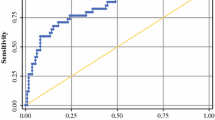Abstract
Clinicians use nodule size to determine which thyroid nodules should receive cytological evaluation. The American Thyroid Association (ATA) has recommended against cytological evaluation for nodules <1 cm. It is unknown, however, if nodule size can accurately discriminate lesions that will represent tumors with favorable versus unfavorable prognosis. Also, the characteristics of thyroid cancers that would not be diagnosed if a strict 1 cm size cut off is used as the threshold for biopsy of intrathyroidal nodules are not well established. Using the Rochester Epidemiology Project, a population-based cohort, we identified all thyroid nodules in Olmsted County residents from 2003–2006. To assess the presence of favorable or unfavorable features for each nodule size cutoff, each patient found to have thyroid cancer was risk-stratified using the ATA risk score, which predicts risk of recurrence and persistent disease. Thyroid cancer cases in which a biopsy was done for factors other than thyroid nodule size or suspicious ultrasound features were excluded. We identified 485 thyroid nodules, 46 (9.5 %) harbored thyroid cancer. Of the 46 thyroid cancers, 37 (7.6 %) had ATA low risk; 8 (1.6 %) had intermediate, and only 1 (0.2 %) had an ATA high risk scores. The frequency of thyroid cancer and the distribution of ATA risk scores were similar across tumor sizes. In thyroid nodules of <1 cm, 92 (87 %) were benign, while 13 (13 %) were malignant (11 % ATA low risk, 2 % ATA intermediate risk) without extrathyroid extension, aggressive histology, or distant metastasis. For all thyroid cancer patients, no cases of persistent disease were found after a median follow-up of 7 years. In this population-based study, we showed that high risk thyroid cancers are rare; indeed, in this highly selected cohort of patients, the ATA’s recommendation to avoid cytologic evaluation in thyroid nodules less than 1 cm would not miss any thyroid cancer with high risk features. However, thyroid nodule size at presentation did not accurately discriminate between tumors with favorable versus unfavorable clinicopathologic features. Thus, if further discrimination is desired, for example, to avoid overdiagnosis, features other than size at presentation need to be evaluated.

Similar content being viewed by others
References
G.H. Tan, H. Gharib, Thyroid incidentalomas: management approaches to nonpalpable nodules discovered incidentally on thyroid imaging. Ann. Intern. Med. 126(3), 226–231 (1997)
C. Reiners, K. Wegscheider, H. Schicha, P. Theissen, R. Vaupel, R. Wrbitzky, P.M. Schumm-Draeger, Prevalence of thyroid disorders in the working population of Germany: ultrasonography screening in 96,278 unselected employees. Thyroid 14(11), 926–932 (2004). doi:10.1089/thy.2004.14.926
J.P. Brito, A.J. Yarur, L.J. Prokop, B. McIver, M.H. Murad, V.M. Montori, Prevalence of thyroid cancer in multinodular goiter versus single nodule: a systematic review and meta-analysis. Thyroid 23(4), 449–455 (2013). doi:10.1089/thy.2012.0156
Haugen B, Oral communication; http://www.thyroid.org/members-only/member-resources/ata-draft-guidelines/. Accessed 23 Sept 2014
L. Davies, H. Welch, CUrrent thyroid cancer trends in the united states. JAMA Otolaryngol. Head Neck Surg. (2014). doi:10.1001/jamaoto.2014.1
M.P. Curado, B. Edwards, H.R. Shin, H. Storm, J. Ferlay, M. Heanue, P. Boyle, Cancer Incidence in Five Continents, vol. IX (IARC, IARC Scientific Publications No. 160, Lyon, 2007)
J.A. Sosa, J.W. Hanna, K.A. Robinson, R.B. Lanman, Increases in thyroid nodule fine-needle aspirations, operations, and diagnoses of thyroid cancer in the United States. Surgery 154(6), 1420–1426 (2013). doi:10.1016/j.surg.2013.07.006. discussion 1426-1427
J.P. Brito, J.C. Morris, V.M. Montori, Thyroid cancer: zealous imaging has increased detection and treatment of low risk tumours. BMJ 347, f4706 (2013). doi:10.1136/bmj.f4706
W.A. Rocca, B.P. Yawn, J.L. St Sauver, B.R. Grossardt, L.J. Melton 3rd, History of the Rochester Epidemiology Project: half a century of medical records linkage in a US population. Mayo Clin. Proc. 87(12), 1202–1213 (2012). doi:10.1016/j.mayocp.2012.08.012
J.L. St Sauver, B.R. Grossardt, C.L. Leibson, B.P. Yawn, L.J. Melton 3rd, Generalizability of epidemiological findings and public health decisions: an illustration from the Rochester Epidemiology Project. Mayo Clin. Proc. 87(2), 151–160 (2012). doi:10.1016/j.mayocp.2011.11.009
J.L. St Sauver, B.R. Grossardt, B.P. Yawn, L.J. Melton 3rd, W.A. Rocca, Use of a medical records linkage system to enumerate a dynamic population over time: the Rochester epidemiology project. Am. J. Epidemiol. 173(9), 1059–1068 (2011). doi:10.1093/aje/kwq482
I. Sugitani, K. Toda, K. Yamada, N. Yamamoto, M. Ikenaga, Y. Fujimoto, Three distinctly different kinds of papillary thyroid microcarcinoma should be recognized: our treatment strategies and outcomes. World J. Surg. 34(6), 1222–1231 (2010). doi:10.1007/s00268-009-0359-x
Y. Ito, A. Miyauchi, H. Inoue, M. Fukushima, M. Kihara, T. Higashiyama, C. Tomoda, Y. Takamura, K. Kobayashi, A. Miya, An observational trial for papillary thyroid microcarcinoma in Japanese patients. World J. Surg. 34(1), 28–35 (2010). doi:10.1007/s00268-009-0303-0
J.P. Brito, M.R. Gionfriddo, A. Al Nofal, K.R. Boehmer, A.L. Leppin, C. Reading, M. Callstrom, T.A. Elraiyah, L.J. Prokop, M.N. Stan, M.H. Murad, J.C. Morris, V.M. Montori, The accuracy of thyroid nodule ultrasound to predict thyroid cancer: systematic review and meta-analysis. J Clin Endocrinol Metab 99(4), 1253–1263 (2014). doi:10.1210/jc.2013-2928
Acknowledgments
This study was made possible using the resources of the Rochester Epidemiology Project, which is supported by the National Institute on Aging of the National Institutes of Health under Award Number R01AG034676. The content is solely the responsibility of the authors and does not necessarily represent the official views of the National Institutes of Health. MRG, SM, and NSO were supported by CTSA Grant Number TL1 TR000137 from the National Center for Advancing Translational Science (NCATS). The contents of this manuscript are solely the responsibility of the authors and do not necessarily represent the official views of the NIH.
Disclosure
RMT is a consultant for Veracyte.
Author information
Authors and Affiliations
Corresponding author
Rights and permissions
About this article
Cite this article
Brito, J.P., Singh-Ospina, N., Gionfriddo, M.R. et al. Restricting ultrasound thyroid fine needle aspiration biopsy by nodule size: which tumors are we missing? A population-based study. Endocrine 51, 499–505 (2016). https://doi.org/10.1007/s12020-015-0713-8
Received:
Accepted:
Published:
Issue Date:
DOI: https://doi.org/10.1007/s12020-015-0713-8




